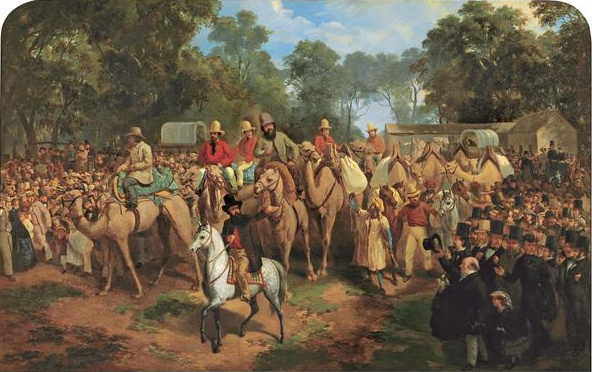 |
| Exploration and Settlement in Australia |
The island continent of Australia was the last to be discovered and explored by Europeans. It was called Terra Australis Incognita, the unknown southern land. The first European to sail into the Australian waters was a Dutchman, Abel Tasman, working for the Dutch East India Company, who discovered the western and southern coast of an island he named Van Dieman’s Land (now Tasmania) in 1618. Subsequent Dutch explorers of areas of coastal Australia called it New Holland.
In the mid-18th-century France and Great Britain also became interested in exploring the unknown land. Between 1768 and 1776 Captain James Cook, an officer of the British Royal Navy, made three great voyages of discovery.
His first voyage sailed around New Zealand and then the eastern coast of Australia. Sir Joseph Banks, a scientist and naturalist who accompanied Cook, recorded the flora and fauna of southeastern coastal Australia, which he named New South Wales, indicating its possibilities for settlement.
 |
Fifteen years after Cook’s discovery, British Home Secretary Lord Sydney decided to set up a penal colony in Botany Bay (named by Banks), where Sydney is today. This was to accommodate the overflowing British jails resulting from the American Revolution, when former British colonies would no longer accept British convicts.
In January 1788 Captain Arthur Philip arrived at Sydney Harbor in charge of 11 ships, 717 convicts and an army detachment named the New South Wales Corps formed for the purpose of guarding them.
Philip oversaw the settlement through 1792, its most critical years, due to lack of food and the unsuitability of convicts as pioneers. Although free settlers began arriving in Sydney from 1793 the main purpose of the settlement remained a repository of convicts.
Three lieutenant governors followed Philip; the third, William Bligh, earlier of the mutiny on the Bounty, was a man of such fiery temperament that his tenure ended with the Rum Rebellion. The cause was the illegal liquor traffic by officers of the New South Wales Corps, the prevalence of drunkenness, and consequent problems.
Bligh’s attempt to rein in the officers resulted in his ouster. Although the leaders of the revolt were punished, the British government recalled Bligh and undertook reforms.
The new governor was Colonel Lachlan MacQuarie who came with his own Scottish regiment. The New South Wales Corps was disbanded and replaced by regular British army units that were rotated for tours of duty.
MacQuarie made extensive reforms, built up the infrastructure, and encouraged exploration into the interior as well as free immigration with land grants. The governors who followed him continued his policies, resulting in accelerated development.
Between 1802 and 1803, Matthew Flinders circumnavigated Australia, proving that it was an island continent and that there was no separate island called New Holland. Flinders recommended the name Australia for the continent, which was accepted. In 1829 Great Britain laid claim to the whole continent.
In 1813 the first overland expedition penetrated the low mountain range that separated the coastal plains of eastern Australia from the interior. Many explorations into the interior discovered river valleys and great grassy plains suitable for agriculture and pasturage.
Waves of settlers followed, encouraged by liberal land grants to free settlers and emancipists (convicts who had served their terms). The natives, known as aborigines, were hunter-gatherers and no match for the white settlers; they were killed, driven off, or survived on the fringes of white society.
Great Britain established several other penal colonies in Australia in addition to the one in Sydney. One established in 1803 in Tasmania was used to house the most violent convicts and to preempt a possible French attempt to seize the island; another was on Norfolk Island, off the eastern coast.
In 1824 Brisbane, north of Sydney on the eastern coast, became another penal settlement—it became the capital of a colony called Queensland. In 1850, convicts were sent to Western Australia at the request of free settlers there because of a severe shortage of labor. Two colonies, Victoria and South Australia, never had penal settlements.
End of the Penal System
As the number of free settlers grew, local opposition to continued transportation gained ground in the Australian colonies. At the same time, the transportation of convicts to remote colonies was questioned in Britain. In 1837 a parliamentary committee investigating the question reported against its continuation, beginning the movement to abolish it.
The last convicts were landed in New South Wales in 1840. By then it had received almost 75,000 convicts, with 25,000 still under sentence. No more convicts were transported to Tasmania in 1853, it having received 67,000 since 1803.
The first move toward representative government came to New South Wales in 1823 with an appointed legislative council. It was enlarged in 1842 to include some elected members, the electorate limited to men, including emancipists, paying certain taxes.
In 1850 the British parliament passed the Australian Colonies Government Act that gave each colony the right to set up its own legislature, determine franchise, tariffs, and make laws, subject to royal confirmation.
The six Australian colonies became states: New South Wales (capital Sydney), Victoria (Melbourne), Queensland (Brisbane), South Australia (Adelaide), which also administered the Northern Territory, Tasmania (Hobart), and Western Australia (Perth).
Each state adopted a constitution that with slight variations provided for a bicameral legislature of elected members (initially on a restricted male franchise) and a cabinet government on the British model.
By the mid-19th century, the interior of Australia had been crisscrossed; gold and other mineral deposits had been discovered and were being worked; steamships and telegraph connected it with other parts of the world; and railway lines were being built. The foundations of an Australian nation had been laid.